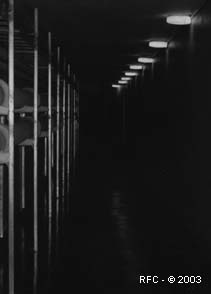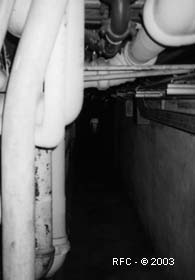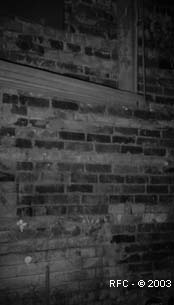Article Index
Page 3 of 3
Trinity College - In Depth
by This email address is being protected from spambots. You need JavaScript enabled to view it.
The Gothic Revival building that is the current home of Trinity College, at 6 Hoskin Avenue, was erected in 1925. The college’s chapel, which forms the western part of the building, was not completed until 1955. This current building is actually the second home of Trinity College, which originally stood on Queen Street West at Bellwoods Avenue. This earlier building was completed in 1851, but now the ornamental gates of that building are the only portion of the old college that still remain.Inside Trinity College is a collection of beautifully executed interiors. As one walks through the main entrance, and proceeds across the corridor, one comes to the college’s quadrangle. Off to the east of the quad, lies a gateway that leads out to Philosopher’s Walk. On the left of this gateway’s arch is a small bust of George VI, and on the right, Queen Elizabeth (later the Queen Mother), hung for the couple’s visit to Canada in 1939. This is the only monument to the late Royal Couple in Toronto. If one turns left, instead, through the main entrance, one reaches the chapel, on the left, or the dining room, Strachan Hall, on the right. Strachan Hall is a wonderful sight, with it’s High Table for the faculty on one end, and an enormous rendering of the Arms of Queen Victoria in the loft at the other end.
THE GHOST OF JOHN STRACHAN
Strachan Hall is, of course, named after the legendary Toronto figure, John Strachan, the founder of Trinity College. On the northern wall of Strachan Hall, there is a large, centuries old tapestry depicting the arrival of the Queen of Sheba at King Solomon’s court. To the right of the tapestry is a portrait of John Strachan himself. Strachan also posed for another portrait, in 1865, which was painted by George erthron. This portrait, which hangs in the Provost’s office (at the east end of the college), is quite striking. No matter where one stands to view this portrait, Strachan’s gaze seems to follow. Berthron, the artist, used a special artistic technique to produce this eerie feature in the painting. The addition of this technique may be more appropriate than Berthron originally realized, because it is said that Strachan himself still keeps watch over this college that he founded.
Strachan led an eventful life. As a young man, he was the chaplain own at Fort York during the War of 1812. When York was over run by American forces, he intervened for the protection of the citizenry and their private property. He went on to become an important member of the Family Compact, was appointed the first Anglican Bishop for the city, and of course, he founded Trinity College. Strachan died on November 1st, 1867, two years after posing for the portrait. However, it is said that his spirit comes back to wander the grounds of Trinity College on, or around, the anniversary of his death, keeping an eternal vigil to ensure that things in the College are being done the way in which he intended. Some years he is seen a few nights after the anniversary of his death, and other years, a few nights before, stalking the halls and grounds in his Bishop’s robes and mitre; and of course, the evening before the anniversary of his death is none other than October 31st, Halloween night.
THE GHOST IN THE CHAPEL
Trinity College’s chapel is a wonderful place for reflection, but it has its fair share of ghostly stories, as well. The main entrance leads in from the southwest part of the college. Just to the right (west) of the altar, is a smaller, more private chapel known as the "Lady Chapel". This area seems to be a centre for paranormal activity.
The stories are diverse. Some see an older lady, almost universally described as looking "grey" in appearance, hovering around that area of the chapel. At times, people have claimed to see her sitting in one of the pews, and then vanishing. Other stories involve her standing patiently outside the chapel, as if waiting for divine services to begin, before disappearing in front of witnesses. One individual even told me that a friend of his had held down a brief conversation with this mysterious, ghostly woman. She seemed "upset" and "emotional". They talked in the main part of the chapel for a few minutes, then she got up, turned into the smaller "Lady Chapel" and vanished!
THE TRINITY COLLEGE STEAM TUNNELS
There are a few stories in circulation about the steam tunnels which run underground, from the main building of Trinity College, westward to St.Hilda’s, the residence for female students on Devonshire Place. These passages are commonly used as an indoor shortcut between the two buildings.
 |
As we made our way through Strachan Hall down into the steam tunnels, she told me one variation of the ghost stories that I hadn’t heard. Her legend had it that a young woman, a student at the college, was assaulted down in the tunnels a number of years ago. To this day, she said, the spirit of that victimized girl wanders the halls as some kind of paranormal vigilante. Upon hearing this ghost story, I gained an entirely new sense of propriety.
The atmosphere of these steam tunnels is very eerie. They are everything that you would imagine a haunted steam tunnel to be - pipes of all different sizes running along the walls, a sense of dampness, and in portions, overhead lights that flicker on and off.
 |
We stopped in front of a portion of brick that is the centre of the other legend of these steam tunnels with which I am acquainted. This portion of the brickwork is about five feet square, and seems to be "patched up" in a fashion that doesn’t match up with the surrounding patterns. This has given rise to the legend of a man being bricked up within that small portion of the wall, long ago. Apparently, he can roam through a limited space up and down these underground corridors, and this he does, in search of souls to drag back to the confines of his hole in the wall. It is said that for every soul he abducts, one of the bricks that holds him in is loosened, and when he has finally captured enough souls, and loosened enough bricks, he will be free to eternally wander the entire University grounds at will. I took a few pictures, and then noticed with a kind of reluctant curiosity that there was a solitary brick lying on the ground in front of this patch. I picked up the brick and slipped it into my pocket for a souvenir. I wouldn’t have dared to verbalize it, but I couldn’t help but wonder if the Trinity student who was showing us around that evening, had noticed if anyone had suddenly stopped turning up for classes lately.

©1997-2003 - GHRS - - Richard Fiennes-Clinton - Muddy York




